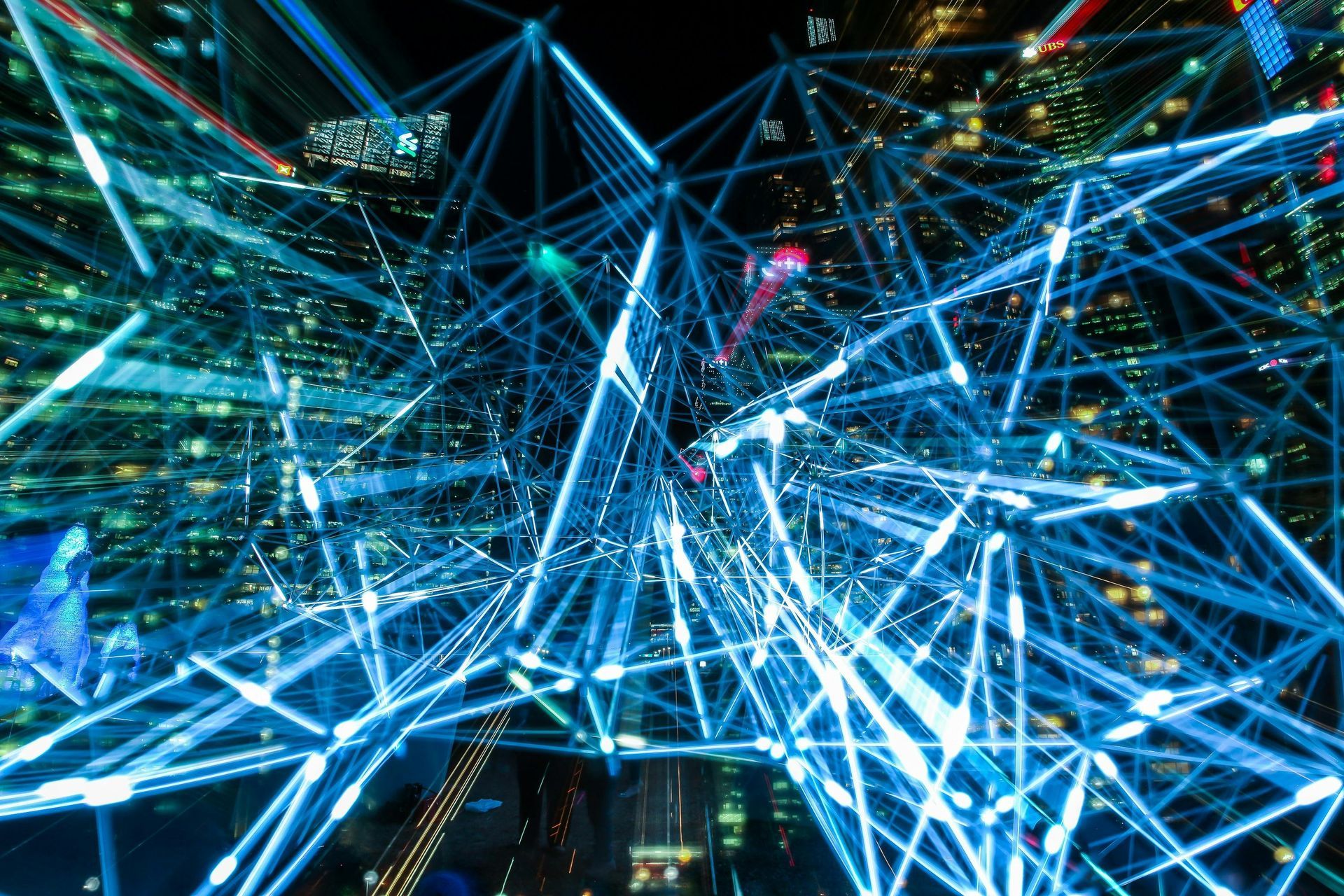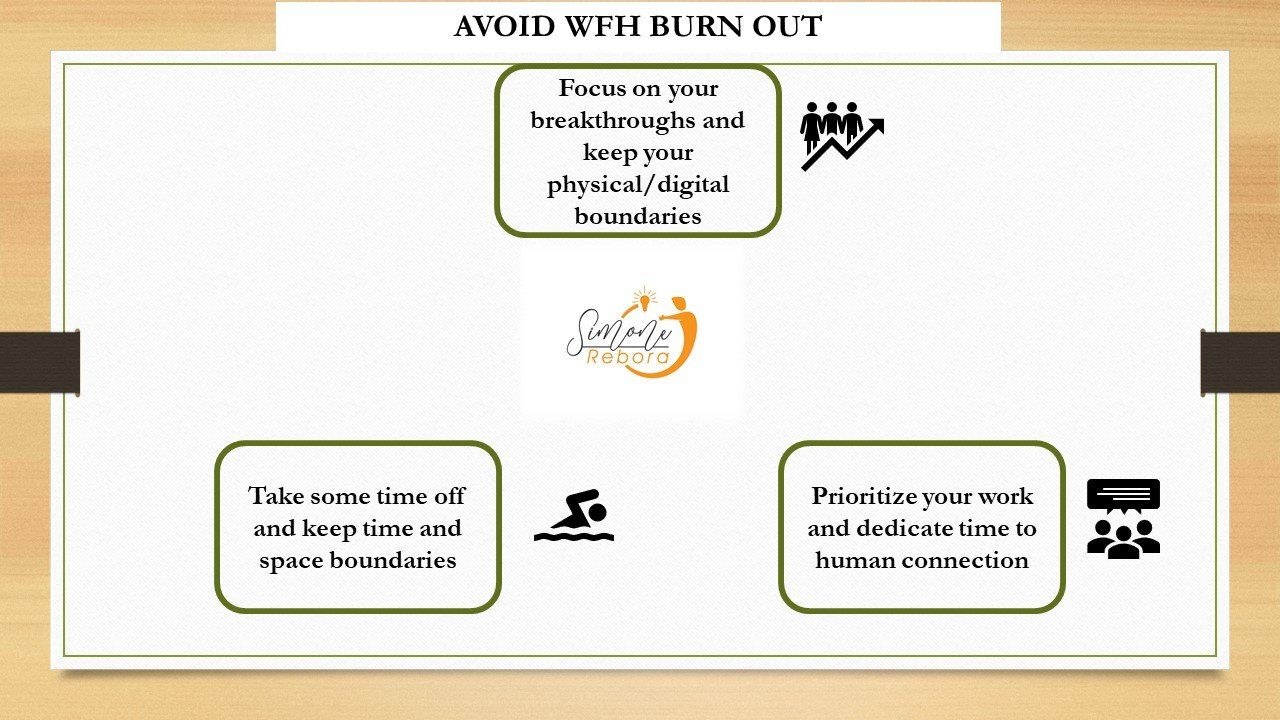AVOID WFH BURNOUT AND OPTIMIZE YOUR REMOTE WORK
Simone Rebora • 25 giugno 2020
When you went to the office every day you had a clear distinction between your work life and your personal life. But now that you know when you start, but not when you finish and your office could be your bedroom, you can end up working all the time if you're not careful. How can you optimize your time?

Millions of people around the world have made a sudden transition to long-distance work in the middle of the Covid-19 outbreak. Consequently, some employers are worried about maintaining employee productivity. From my perspective, they should really concern about in this out of ordinary situation is a long-term risk:
employee burnout.
The risk is really very high. The boundaries between work and relaxation are blurring in new and unusual ways, and many employees working at home for the first time are struggling to keep the boundaries between their professional and personal lives healthy. At this point comes the desire to show loyalty, dedication and productivity, so as to facilitate non-stop work.
Recently, I have been reviewing the latest research from the leading universities such as Harvard and London Business School. In summary, they suggested 3 important tips to avoid burnout and 3 ways maintain happiness, even in the middle of pandemic. It’s nice to see how easily we can fall into burnout, forgetting positive emotions and focusing on anxiety and depression: we must work at home with efficiency and happiness, possibly increasing our well being.
FOCUS ON YOUR BREAKTHROUGHS AND KEEP YOUR PHYSICAL/DIGITAL BOUNDARIES
As you adapt to your new routine,
are you making daily improvements along the way? Consider what new objectives you have created that you are making progress on. Wear your work clothes every morning and consider replacing your car commute with a walk in a park, or healthy exercise, before sitting down to work. Some workers have already devised creative and original ways to maintain their usual work routine. also, create a space dedicated exclusively for work, where you only sit down when you are working
TAKE SOME TIME OFF AND KEEP TIME AND SPACE BOUNDARIES
Most of the happiness of your job is to give you time, space and activities to rest and relax. This is truer than ever right now. When you feel anxious, tired, and unable to concentrate on your job, the main reaction may be to try to overcome the anxiety and ignore it by continuing to work. I am convinced that
if you continue like this, it will probably make you very inefficient - and it may bring out strong negative feelings that will affect your long-term well-being and productivity. Create spaces where you can also take some time to recover and enjoy some happiness by spending time outdoors, with family or friends. Don't read emails, don't bring your work phone, free your mind and have fun, you will be more efficient and productive when you get back to work. Put slots in your diary where you and your team can spend time. Leaders need to help employees structure, coordinate and manage the pace of work. It may be helpful to create virtual check-ins, virtual coffee breaks or quick meetings dedicated to wondering how life is going. It is essential to maintain a sense of normality.
PRIORITIZE YOUR WORK AND DEDICATE TIME TO HUMAN CONNECTION
It is more important than ever to maintain relationships with colleagues, friends and family, especially when the technology allows it.
This is particularly important for work because, when we work remotely, we tend to reach people only for functional reasons (like when we need them to do something for us, or vice versa). For example, when we teleconference, connecting virtually rather than face-to-face, we are more likely to stick to tasks alone and interact personally in the way that we would do face-to-face. It is essential that we leave time and space for those informal, relaxing chats to connect with people on a human and personal level. Working non-stop, even on the most important tasks, is not the answer.
According to some estimates, a worker is productive on average only three hours a day, and these hours should be free of interruptions or distractions. Even before Covid-19, employees found it difficult to carve out three continuous hours to focus on their core tasks. With the elimination of the boundaries between work and family, employees' time has never been so fragmented.
Employees who always feel "on" are more at risk of burnout
(concerning this topic, I found this meaningful article entitled "Things to Watch Out for While Working Remotely", follow the link: https://www.toptal.com/remote/remote-work-burnout-a-cautionary-tale)
when they work from home than when they go to the office.
In the long term, we never disconnect, always answer emails, whatsapp or telephone - it is not only counterproductive, but also detrimental to our well-being.
Do you think answering an email at midnight is different than answering at 9am the next morning?
I guess these tips aren’t easy to implement, but we should try in order to improve our life balance and manage the new way of interaction that we are going to encounter during in the following months. Do you think that we will have the same relationships? In order to improve our job life,
we should consider changing some habits that we have and adapt virtual meetings to the unmet needs.
Recently I attended to a compelling virtual conference organized by IQVIA, an American multinational company of biopharmaceutical development and commercial outsourcing services, which discussed remote engagement and how to maximize it. In the world’s largest countries during May 2020 vs May 2019 there was a big drop of F2F interaction between pharma companies and stakeholders, while a huge increase of remote activity. So, I suppose that we have to be prepared to lead a remote interaction, don’t we?
We should start from the selection of attendees for every event, to be sure that they are interested in the topic. In addition, it’s essential a meaningful promotion of the event and a follow up to request feedback. Generally, the trend of a virtual event, specifically for HCPs, must keep in mind 3 important aspects:
1) On average
63% of the members attend the meeting
2)
50 minutes is the average viewing time during live presentations
3)
34 minutes is the average
viewing time of on demand content
Consider that the series events are more successful than a single event
because generate opportunities to refine messaging and frequency, minimize the time spent “out of the field” and it is more likely it’ll differentiate from competitors. Remember to focus on looking into the camera, not the screen; maintain a strong voice; engage attendees with direct questions calling him/her by name; organize final Q&A interactive sessions using virtual tool like Mentimeeter or Google survey.
In conclusion, the coming months are likely to be similar to the past few, with remote working and social distances, so we need to:
- Find the right balance between job and private life
- Respect ourselves, familiars and colleagues
- Be efficient and productive in virtual interactions
Our next challenge and opportunity are to be strong remote leaders, respecting wellbeing and familiar space of all our people.
Please, have a look at my "Avoid WFH burn out framework" at the bottom of my article
:-)
What do you think?
Let me know your feedback!
--------------------------------------------------------------------------------------------------------
Milioni di persone in tutto il mondo hanno cambiato radicalmente il proprio modo di lavorare, proprio nel bel mezzo dell'epidemia di Covid-19. Molto spesso, alcuni datori di lavoro sono preoccupati di mantenere la produttività dei dipendenti, anche se, dal mio punto di vista, dovrebbero principalmente preoccuparsi di un'altra situazione che potrebbe essere vista come un rischio a lungo termine:
il burnout dei dipendenti.
Il rischio è davvero molto alto.
I confini tra lavoro e relax stanno sfumando in modi nuovi e inusuali e molti dipendenti che lavorano a casa per la prima volta stanno cercando di mantenere vivi i confini tra la loro vita professionale e quella personale. Per di più si attiva il desiderio di dimostrare lealtà, dedizione e produttività all'azienda, cosa che non fa altro che facilitare il lavoro non-stop.
Recentemente, ho passato in rassegna le ultime ricerche delle principali università come Harvard e la London Business School. In sintesi, ho catturato 3 consigli importanti per evitare il burnout e 3 modi per mantenere la felicità, anche nel bel mezzo di una pandemia. È strano vedere con quanta facilità possiamo cadere nel burnout, dimenticando le emozioni positive e concentrandoci su ansia e depressione: dobbiamo lavorare a casa con efficienza e felicità, possibilmente aumentando il nostro benessere.
CONCENTRATEVI SULLE VOSTRE SCOPERTE E MANTENETE I VOSTRI CONFINI FISICI/DIGITALI
Mentre vi adattate alla vostra nuova routine, state migliorando di volta in volta? Considerate quali sono i nuovi obiettivi che avete settato e su cui state facendo progressi. Vestitetvi come se doveste andare a lavoro ogni mattina
e considerate la possibilità di sostituire il viaggio in auto con una passeggiata nel parco, o con un sano esercizio fisico, prima di sedervi al lavoro. Alcuni lavoratori hanno già escogitato modi creativi e originali per mantenere la loro nuova routine, creando uno spazio dedicato esclusivamente al lavoro, nel quale sedersi solo ed esclusivamente quando si lavora.
PRENDETEVI UN PO' DI TEMPO LIBERO E MANTENETE I CONFINI DEL TEMPO E DELLO SPAZIO
La maggior parte della felicità del vostro lavoro consiste nel darvi tempo, spazio e attività per riposare e rilassarvi. Questo è più vero che mai in questo momento. Quando vi sentite ansiosi, stanchi e incapaci di concentrarvi sul vostro lavoro, la reazione principale è quella di cercare di superare l'ansia ignorandola, continuando a lavorare. Sono convinto che se continuate così, probabilmente questo vi renderà molto inefficienti - e potrebbe far emergere forti sentimenti negativi che influenzeranno il vostro benessere e la vostra produttività a lungo termine. Create degli spazi in cui potete anche prendervi un po' di tempo per recuperare e godervi un po' di felicità passando del tempo all'aperto, con la famiglia o con gli amici. Non leggete le e-mail, non portate il telefono del lavoro, liberate la mente e divertitevi, sarete più efficienti e produttivi quando tornerete al lavoro. Mettete degli spazi nella vostra agenda dove voi e il vostro team potete trascorrere del tempo insieme. I leader devono aiutare i dipendenti a strutturare, coordinare e gestire il ritmo di lavoro. Può essere utile creare check-in virtuali, pause caffè virtuali o riunioni veloci dedicate a chiedersi come va la vita.
È essenziale mantenere un senso di normalità.
DATE PRIORITÀ AL VOSTRO LAVORO E DEDICATE TEMPO AL CONTATTO UMANO
È più importante che mai mantenere i rapporti con colleghi, amici e familiari, soprattutto quando la tecnologia lo permette. Questo è particolarmente importante per il lavoro perché, quando lavoriamo a distanza, tendiamo a raggiungere le persone solo per motivi funzionali (come quando qualcuno ti contatta solo se ha bisogno, o viceversa). Ad esempio, quando ci colleghiamo nelle virtual call è molto probabile che andremo dritto al sodo, senza coltivare un minimo di "greetings". È essenziale lasciare tempo e spazio a quelle chiacchierate informali e rilassanti per connettersi con le persone
a livello umano e personale. Lavorare senza sosta, anche sui compiti più importanti, non è la risposta.
Secondo alcune stime, un lavoratore è produttivo in media solo tre ore al giorno, e queste ore dovrebbero essere prive di interruzioni o distrazioni. Anche prima del Covid-19, i dipendenti trovavano difficile ritagliarsi tre ore continue per concentrarsi sui loro compiti principali. Con l'eliminazione dei confini tra lavoro e famiglia, il tempo dei dipendenti non è mai stato così frammentato.
I dipendenti che si sentono sempre "on" sono più a rischio di burnout quando lavorano da casa che quando vanno in ufficio.
A lungo termine, non ci disconnettiamo mai, rispondere sempre alle e-mail, ai messaggi di posta elettronica o al telefono: non solo è controproducente, ma anche dannoso per il nostro benessere.
Pensi che rispondere a un'e-mail a mezzanotte sia diverso dal rispondere alle 9 del mattino dopo?
Immagino che questi consigli non siano facili da implementare, ma dovremmo cercare di
migliorare il nostro equilibrio di vita,
gestendo il nuovo modo di interagire tra noi che prenderà sempre più piede nei mesi a venire. Pensate che avremo gli stessi rapporti interpersonali della fase pre Covid? Per migliorare la nostra vita lavorativa, dovremmo considerare di cambiare alcune abitudini che abbiamo e far sì che i virtual meeting diventino un mezzo per rispondere alle nostre esigenze.
Recentemente ho partecipato ad una interessante conferenza virtuale organizzata da IQVIA, nata dalla fusione tra IMS Health e Quintiles; IQVIA è un provider globale di informazioni, tecnologie innovative e servizi di ricerca clinica in grado di supportare le aziende del settore Life Sciences nel ripensare l’approccio alla ricerca e alla commercializzazione. Durante la conferenza l'hot topic è stato la discussione su come poter massimizzare l'ingaggio e le interazioni a distanza con i propri customers. Nei Paesi con il maggior mercato farmaceutico, nel corso di maggio 2020 rispetto a maggio 2019 c'è stato un forte calo dell'interazione F2F tra le aziende farmaceutiche e i stakeholders, mentre vi è stato un enorme aumento dell'attività a distanza. Quindi, suppongo che
dobbiamo essere pronti a condurre e gestire una web call
(per esempio) cercando di mantenere sempre alta l'attenzione e l'interazione, vero?
Per prima cosa, dovremmo partire dalla
selezione dei partecipanti per ogni evento, per essere sicuri che siano interessati all'argomento. Inoltre, è essenziale una
promozione significativa dell'evento e un follow-up per richiedere un feedback. In generale, l'andamento di un evento virtuale, specifico per i professionisti della sanità, deve tenere conto di 3 aspetti importanti:
1) In media il
63% degli iscritti partecipa all'evento
2)
50 minuti
è il tempo medio in cui viene seguita una presentazione
3)
34 minuti
è il tempo medio di visione dei contenuti on demand
Fondamentale tenere a mente che
gli eventi in serie hanno più successo di un singolo evento:
generano opportunità per affinare i key messages e la loro frequenza, riducono al minimo il tempo trascorso fuori dagli ospedali ed è più probabile che si differenzino dalla concorrenza. Ricordatevi di concentrarvi sull'obiettivo della telecamera, non sullo schermo; mantenete una voce forte; coinvolgete i partecipanti con domande dirette chiamandoli per nome; organizzate sessioni interattive di domande e risposte finali utilizzando strumenti virtuali come Mentimeeter o il Google survey.
In conclusione, i prossimi mesi saranno probabilmente simili a quelli passati, con tanto smart working e distanziamento sociale, quindi dal mio punto di vista dovremmo:
- Trovare il giusto equilibrio tra lavoro e vita privata
- Rispettare noi stessi, i familiari e i colleghi
- Essere efficienti e produttivi nelle interazioni virtuali
La nostra prossima sfida e quindi opportunità è quella di essere grandi leader a distanza ed in virtuale, rispettando il benessere e la sfera familiare di tutto il nostro Team.
Date un'occhiata al mio framework "Avoid WHF burnout" in fondo al mio articolo :-)
Cosa ne pensate?
Fatemi avere un vostro feedback!

Over the past months, through my LinkedIn series “Chapter: The Promise Journey,” I have explored how AI is weaving a transformative red thread throughout pharma’s complex ecosystem. This article offers a comprehensive summary and reflections on the early stages of this journey, highlighting the immense promise AI holds, and the leadership and cultural shifts required to fully realize its potential.

As artificial intelligence reshapes the pharmaceutical landscape, I am compelled to synthesize the key milestones and reflections from my LinkedIn series, The Promise AI Journey, into this first comprehensive summary. This article distills lessons from building AI roadmaps, navigating Pharma’s unique challenges, and envisioning a future where AI accelerates both innovation and ethical responsibility.


